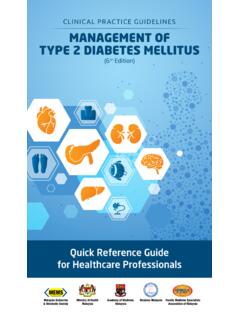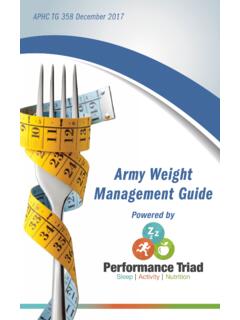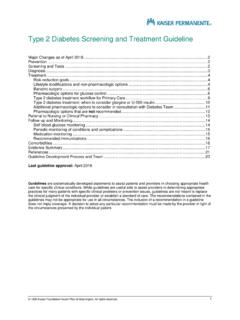Transcription of NHS England » Diagnosis and management of type 2 diabetes ...
1 CYPWMDN Type 2 DM Guideline, June 2019. Due for review June 2021 1 Diagnosis and management of Type 2 diabetes (T2DM) in Children and Young People (CYP): Clinical Practice Guideline Team: Dr Caroline Godber 1, Catarina Leal 1, Deborah McCausland 2, Hilary McCoubrey 1, Dr Nisha Pargass 3 Dr Radhika Puttha 4, Dr Rajesh Sakremath 5 Admin support: Marie Atkins 1 Expert Advice: Prof Tim Barrett1 1. Birmingham Women s and Children s Hospital NHS Foundation Trust 2. Walsall Healthcare NHS Trust 3. The Royal Wolverhampton NHS Trust 4.
2 George Eliot Hospital Trust 5. The Shrewsbury and Telford Hospitals NHS Trust Chair & Correspondence: Dr Rajesh Sakremath Consultant Paediatrician, Princess Royal Hospital, Telford TF1 6TF e-mail: Version: 1st Edition, 12th April 2019 Ratified: 20th June 2019 CYPWMDN Type 2 DM Guideline, June 2019. Due for review June 2021 2 Contents 1. Introduction: ..5 2. Diagnosis : ..6 3. Type 2 diabetes characteristics: ..7 Characteristics indicative of T2DM include: ..7 Further considerations at Diagnosis : ..7 Diagnosis and determination of the diabetes type.
3 7 History: ..8 Clinical assessment: ..8 Investigations: ..8 4. Prediabetes: ..9 5. management Goals for T2DM: ..9 6. management of T2DM: ..9 lifestyle modification including weight loss advice and exercise management : ..9 Diet: .. 10 weight management : .. 10 Blood glucose management (BG): .. 10 Healthy eating and key nutrients: .. 10 Vitamin D: .. 11 Vitamin B12: .. 11 Magnesium: .. 11 Cardiovascular health: .. 11 exercise : .. 11 Sleep: .. 12 Glycaemic control : .. 12 Self-Monitored Blood Glucose (SMBG): .. 12 HbA1c Monitoring: .. 13 CYPWMDN Type 2 DM Guideline, June 2019.
4 Due for review June 2021 3 Pharmacological therapy: .. 13 Initial Treatment: .. 14 Subsequent Treatment: .. 14 Structured Education for diabetes management : .. 15 Smoking and substance misuse: .. 16 Social and emotional support: .. 16 Screening and management of comorbidities and complications: .. 17 Microalbuminuria: .. 17 Hypertension: .. 18 Treatment of hypertension: .. 18 Dyslipidaemia: .. 18 Hypertriglyceridemia: .. 19 Non-Alcoholic Fatty Liver Disease (NAFLD): .. 19 diabetes Retinopathy: .. 19 diabetes Neuropathy.
5 20 diabetes Peripheral Neuropathy (DPN): .. 20 Diabetic Autonomic Neuropathy (DAN): .. 20 Polycystic Ovarian Syndrome (PCOS .. 20 Obstructive Sleep Apnoea (OSA): .. 20 Atherosclerosis and Vascular dysfunction:.. 21 Immunisation: .. 21 Dental examination: .. 21 Additional health problems .. 21 7. Surgery for CYP with T2DM: .. 21 8. Other therapies and research update: .. 21 Bariatric surgery: .. 23 Current research studies: .. 23 9 References: .. 24 CYPWMDN Type 2 DM Guideline, June 2019. Due for review June 2021 4 10.)
6 Appendices: .. 27 Appendix 1. BMI centile charts:.. 27 Appendix 2. Blood pressure centiles, Age 1- 17 years: .. 29 Appendix 3: Recommendations on methods of achieving goals: .. 33 Appendix 4: Nutrients additional information: .. 35 Appendix 5: exercise .. 36 CYPWMDN Type 2 DM Guideline, June 2019. Due for review June 2021 5 1. Introduction: The incidence of Type 2 diabetes (T2DM) in Children and Young People (CYP) is rising globally in parallel with the rising rates of childhood obesity. In 2005, the UK annual incidence of T2DM in CYP < 17 years was per 100,000 per year rising to per 100,000 per year in 2015.
7 The 2016-17 National Paediatric diabetes Audit (NPDA) 33 reported that TD2M accounted for % of the cohort. A proportionally higher number of cases are seen in adolescent females and CYP from Black and Asian ethnic backgrounds. Additional risk factors associated with T2DM include obesity, positive family history and low socioeconomic status. Approximately 35% of CYP are asymptomatic at Diagnosis with the Diagnosis being made after an incidental glucose finding or further investigations for obesity related co-morbidities. Diagnostic challenges do remain as being overweight and obese can also occur in children diagnosed with Type 1 diabetes (T1DM).
8 Diabetic KetoAcidosis (DKA) can be a presenting feature of T2DM with some series reporting a rate up to 25%. Accurate Diagnosis of T2DM is critical for appropriate treatment, educational approaches, dietary modification and prevention of adverse outcomes. T2DM in CYP compared to adults demonstrate unique features such as rapid decline in cell function and accelerated development of microvascular and macrovascular complications. Non-Alcoholic Fatty Liver Disease (NAFLD), hypertension, dyslipidaemia and microalbuminuria can be present at Diagnosis and the prevalence increases with the duration of diabetes .
9 This underlies the importance of screening for all complications and associated co- morbidities including Polycystic Ovarian Syndrome (PCOS), Obstructive Sleep Apnoea (OSA) and psychological co-morbidities. CYP onset T2DM has become more common, carries a high disease burden and is associated with increased short term and long term morbidity. Early detection, institution of a multi-faceted management approach and early screening and management of complications will help to preserve the future health of the affected individual. These clinical practice guidelines are based on the best available evidence.
10 It incorporates guidance surrounding Diagnosis , initial and subsequent treatment, on-going monitoring and screening for and management of complications. CYPWMDN Type 2 DM Guideline, June 2019. Due for review June 2021 6 2. Diagnosis : (according to American diabetes Association criteria) 8 Diagnosis of T2DM is based on measurement of glucose levels AND the presence of symptoms and requires two steps; Confirmation of the presence of diabetes , and Determination of the type (mainly based on typical characteristics) Any one or more of these symptoms will give a Diagnosis of diabetes , further investigations maybe needed for the type of diabetes (T1DM, T2DM, MODY etc).















